|
|
#51
|
||||
|
||||
|
bonus content. This chart here shows the cards where the 3 scarcest backs all have a combined PSA/SGC population of 3 or less.
I would say these cards would be insanely difficult to complete back runs for  And if my numbers are right, the hardest back run of them all is technically Doyle With Bat, that has 3 pop 1s (BL 460, Drum, Hindu Red). The BL 460 shows up as possible on T206resource. SGC shows an SGC 1 copy graded. That is...tough.
__________________
My T206 research thread My T205 Census thread Want list: M101-2, T205s (American Beauties) Last edited by 53toppscollector; 08-26-2022 at 11:03 AM. |
|
#52
|
|||
|
|||
|
Wow
Thank you for doing this |
|
#53
|
|||
|
|||
|
I love baseball cards and data, this is fantastic. Great research
|
|
#55
|
|||
|
|||
|
Brilliant work. Best Ive ever seen. I just wish youd waited another five or 10 years or so before you posted it. :-) Lots of open secrets about back scarcity are now a lot more open.
|
|
#56
|
||||
|
||||
|
This is really amazing, thank you for putting this data together. Great presentation with the different colors too. Very easy to read.
__________________
ThatT206Life.com |
|
#57
|
|||
|
|||
|
Now for the really hard part . . . Plenty of cards graded by PSA and SGC dont get entered into the pop reports. Heres an example: Danny Hoffman with a Tolstoi back. It isnt listed on either pop report; hence, it isnt on your rankings. But I remember very well when this one sold in 2016. It even says Tolstoi on the flip. Ive never seen another one.
https://sales-history.pwccmarketplac...y%20Hoffman%20 |
|
#58
|
|||
|
|||
|
Quick follow-up note: To see the Tolstoi Hoffman scan youll need to scroll down a little ways after clicking the link.
|
|
#59
|
||||
|
||||
|
Yep there are definitely items missing, some items were crossed over so they are "double counted", etc.
On one hand, these are "open secrets", maybe, on the other hand, none of this information is actually secret. I think my interest in this is partly because I love the T206 set, and partly because I am very much into data and trying to see things from different angles. I think a lot of the types of people who collect master sets or some type of version of a master set already knew 99% of this information. If a few more people are now clued in that might mean I miss out on a few cards, but I can't worry about that. This is as much a piece of American history as it is a hobby of mine. I like sharing data and information and learning something new, so hopefully it proves useful to others too. |
|
#60
|
|||
|
|||
|
T206 overload!!! I love it James. Thank you for doing this. Makes me realize how much I'm living (financially) in the print group 1 realm when it comes to trying for harder backs to include in my off-back set build. It's interesting to note, I just picked up a Bill Hinchman Sov.150 (raw) on eBay for about $5o. Theres a poor graded Hindu currently listed for $7oo, yet your research shows a pop. of 14 Sovereigns (#1 toughest back) compared to 20 Hindus (#3 toughest back)...sometimes the overall scarcer back is going to trump the actual scarcer back...an album full of Sovereigns or an album full of Hindus?
Last edited by RCFire82; 08-21-2022 at 09:17 PM. |
|
#61
|
|||
|
|||
|
Similar effect with the aforementioned Piedmont 42's.
Last edited by RCFire82; 08-21-2022 at 09:19 PM. |
|
#62
|
||||
|
||||
|
Quote:
In Print Group 1, there are 68 subjects (updated this, initially had 71 but my sheet was filtered incorrectly) that have both a Sovereign 150 and a Sovereign 350. The exact counts of those is likely impossible to determine. In that subset of 71, 44 of them also have a Hindu Brown back. In most cases, the population of the Sov150 is close to the Hindu. There are a few interesting cases, however, where the Hindu is much more rare than the Sovereign 150. Those are: Bradley Portrait: 18 Hindu // 31 Sov 150 Davis: 14 Hindu // 33 Sov 150 Joss Portrait: 14 Hindu // 30 Sov 150 Wagner Bat on L Shoulder: 14 Hindu // 30 Sov 150 Young Portrait: 19 Hindu // 33 Sov 150
__________________
My T206 research thread My T205 Census thread Want list: M101-2, T205s (American Beauties) Last edited by 53toppscollector; 08-26-2022 at 09:21 PM. |
|
#63
|
||||
|
||||
|
Quote:
That's because PSA used T206resource checklists but they haven't updated their pop report data in several years to include newly confirmed cards and Danny Hoffman wasn't confirmed with a Tolstoi back until 2016 so if PSA doesn't update their lists you won't see that combo in the pop reports until SGC grades one. I have a few T206's that are recently graded PSA cards with all the info on the label that aren't listed in their pop reports or set registry. Last edited by Pat R; 08-21-2022 at 09:57 PM. |
|
#64
|
||||
|
||||
|
Also, I am going to fix some of the formatting/sizing on the charts tomorrow, because it will drive me insane if I don't. I will wait to see if anyone finds any other errors or things I need to fix before I re-create the charts and update them.
|
|
#65
|
|||
|
|||
|
A very minor nit . . . In post #62 above, did you mean to say Wagner left shoulder instead of right shoulder?
Separately, another example of a 350-only Tolstoi back that isnt in either of the pop reports is Stephens. I believe it probably is scarcer than any of the backs shown in your spreadsheet. |
|
#66
|
||||
|
||||
|
Quote:
|
|
#67
|
|||
|
|||
|
Heres another pop zero 350-only Tolstoi: Ira Thomas. This is the only copy Im aware of thats been graded by PSA or SGC.
https://bid.robertedwardauctions.com...e?itemid=98759 |
|
#68
|
||||
|
||||
|
Thanks to everyone that commented/PMed me about errors and items to add that are not in either the PSA/SGC pop report.
I really wish they had a functionality where you could submit updates/corrections to the POP reports and they'd be handled quickly. Some of us take this very seriously! Anyway, I have re-formatted the charts to remove a few little things that were bugging me, and I made in the updates people provided. A change log is at the bottom of the last post on the last page. As I noted, I plan to re-update my population counts again in a few months, and if anything changes, I will be sure to update it here. |
|
#69
|
|||
|
|||
|
Fantastic data and research. Serious thread of the year candidate right here.
|
|
#70
|
||||
|
||||
|
So now that I've had a chance to kind of zoom out and look at the data I put together, I have some thoughts:
* Old Mill is underrated as a back, in general. And it is not just the 150 series HoF, there are so many very low pop Old Mills. Print Group 2 Old Mills are more plentiful (around 30 or so combined copies per front), Print Group 3 are plentiful (around 40-45 per front, on average), but they got tougher in Print Group 4, averaging only about 26 per front. Within Print Group 4 there are a bunch of very tough Old Mills, including 12 subjects that have less than 10 total combined copies. McGraw Glove at Hip has 105 copies of a Sovereign 460 back, but only 8 Old Mills, for instance. * The American Beauty 460 sub-group is really fascinating to me. The same 12 cards mentioned above in the Old Mill group are very plentiful in AB 460 backs while being very very hard in OM backs. That group is Crandall With Cap Devore Duffy Ford Gandil Geyer Hummel McGraw Glove at Hip Pfeffer Sheckard Glove Shows Tannehell (Tannehill on Front) Wheat These 12 cards all share a very similar card profile that I find super interesting: -- AB 460 backs are very plentiful -- Sovereign 460 backs are very plentiful -- Tolstoi backs are very plentiful -- SweetCap Factory 42 backs are very plentiful -- Old Mill Backs are very scarce -- EPDG backs are scarce -- Polar Bear backs are scarce (relatively) -- Cycle 460 backs are scarce * Tolstoi backs are either very very rare or very very plentiful as a whole. The average number of Tolstoi examples for all subjects is 17, based on my numbers. However, there are 50 subjects with a pop of 5 or less! Tolstoi is generally not considered rare (by T206 standards) but as we see above in the charts and in the comments, there are a ton of very rare Tolstois out there and I am sure a few more will continue to pop up. * I know this is bordering on sacrilege, but is it possible that Hindu Brown is.....overrated? According to my numbers, the average combined population for Hindu Brown per front is 20. That isn't Polar Bear, sure, but the average is also higher than Tolstoi, per subject, as noted above. Yet Hindu Browns command a massive premium over all the other moderate off backs. Now, there aren't any fronts that have a massive number of Hindu Browns. I count a total of 11 subjects that have 30 or more combined Hindu Browns: - Bresnahan Portrait - Fritz (SL) - Greminger (SL) - WaJo Portrait (38 examples, most populous) - Leifield Pitching - Lipe (SL) - McCauley (SL) - Persons (SL) - Revelle (SL) - Shaughnessy (SL) (38 examples, most populous) - Sullivan Of those 11, 7 of them are SLers. On the flip side, there are only 8 subjects that have 10 or fewer Hindu Browns: - Delehanty (Washington) - Ewing - Killian Pitching (7 copies, rarest) - O'Leary Portrait - Owen - Schmidt Throwing - Stone - Wilhelm Hands At Chest For those 8 cards, the Hindu Brown is not the clear cut scarcest back in a number of cases: - Delehanty (EPDG is more scarce) - Ewing (Hindu Brown is the most scarce) - Killian Pitching (Hindu Brown is the most scarce) - O'Leary Portrait (Old Mill is the most scarce) - Owen (Old Mill/Hindu Brown are tied for most scarce) - Schmidt Throwing (Old Mill is the most scarce) - Stone (Hindu Brown is the most scarce) - Wilhelm Hands At Chest (Old Mill and Hindu Brown are tied) Hindu Brown is definitely a rare back, it was only available during the early part of T206 production, but is the price people are willing to pay a bit distorted based on population counts and relative scarcity? Not sure. Maybe?
__________________
My T206 research thread My T205 Census thread Want list: M101-2, T205s (American Beauties) Last edited by 53toppscollector; 08-22-2022 at 11:59 AM. |
|
#71
|
|||
|
|||
|
For the Exclusive 12, do your numbers show that these subjects are unusually scarce with Sweet Cap Factory 42 overprint backs? See Duffy, for example. Similarly, do your numbers show these subjects are relatively more plentiful with red Hindu backs? Thats been my experience, and Ted Z has pointed this out many times.
And on a personal note, would some kind soul out there please sell me an EPDG Hummel? Any condition will do! |
|
#72
|
||||
|
||||
|
Quote:
 * Hindu Red for those averages 16 per front * The average for the other subjects with a Hindu Red excluding those 12 is only 4. So they are exponentially more populous with Hindu Red backs than the other subjects that have a Hindu Red back * The SC 460/42 OP average for all fronts that have at least 1 copy is 12, and the average for the Exclusive 12 is 8, so slightly lower. A few are quite rare (Devore, Pfeffer), but of course we don't really know how many of these exist because of labeling issues |
|
#73
|
||||
|
||||
|
One of the big thrills for me, when looking at that last table, is that we should expect to find an Uzit for those remaining where the cell is blank. Maybe it will happen, maybe it won't, and we know that if it does, we'll likely only find a small handful.
Everyone wants to own a Honus Wagner (I do, as well) but what I would really love would be to have old records from ATC that detail print runs, how many were actually made of each, etc. There are so many mysteries and things we don't know, and finding that set of written books/ledgers would be even more exciting to me than the next Drum or Lenox or Uzit find.
__________________
My T206 research thread My T205 Census thread Want list: M101-2, T205s (American Beauties) Last edited by 53toppscollector; 08-22-2022 at 02:07 PM. |
|
#74
|
|||
|
|||
|
Grazie.
Youre right about brown Hindu backs being overrated, of course. But they look so, so cool. When I look at the numbers, the glaring candidates for most overrated are the Polar Bear Demmitt and OHara. I realize these subjects are less common than most Piedmont and Sweet Cap backs, and its also true that every 520 set needs both. But they are not rare. A Tolstoi Demmitt (N.Y.) is far rarer than a Polar Bear Demmitt (St. Louis), just as an Old Mill Magee is much scarcer than a Piedmont Magie error card. Maybe someday more Monster collectors will care. |
|
#75
|
|||
|
|||
|
Quote:
James 1st For the past 7 years, I have been working to achieve a complete RUN of the Exclusive 12 group. Five years ago, I acquired the UZIT McGraw which completed his 13-card run...... 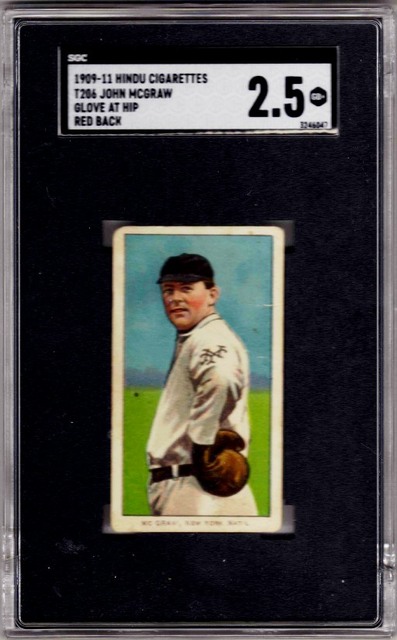 . . . . 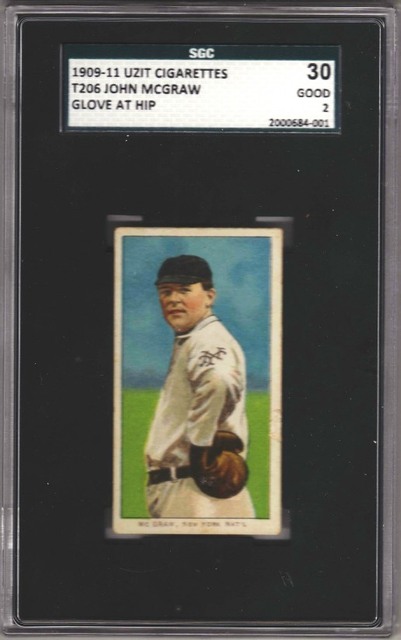  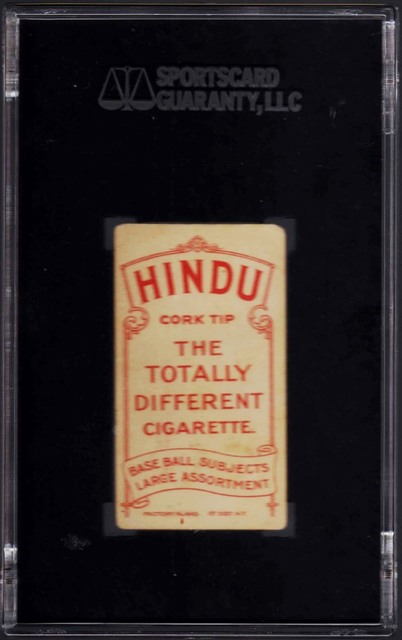  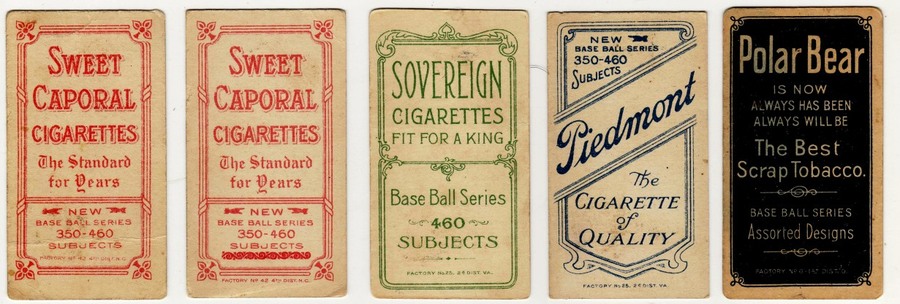 Factory #42.....................Factory #42 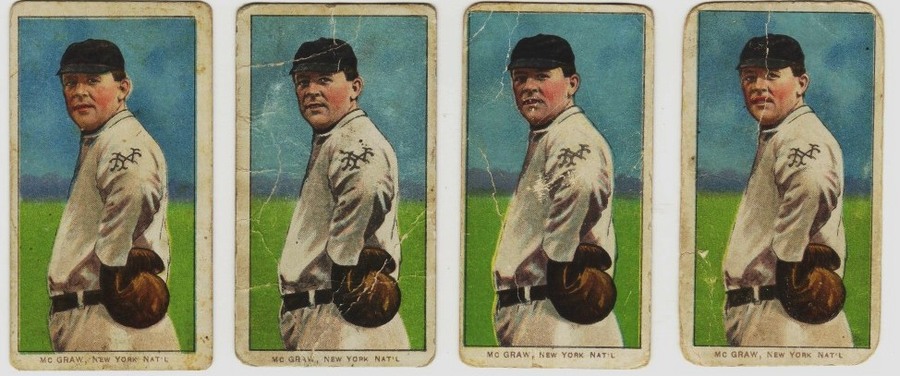  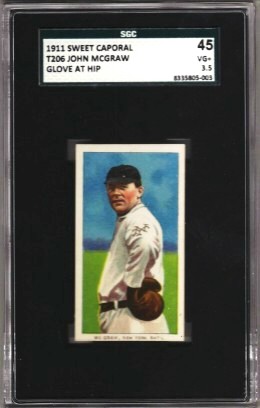 . . . . 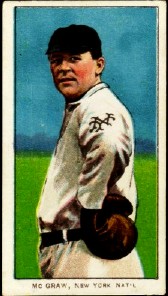 . . 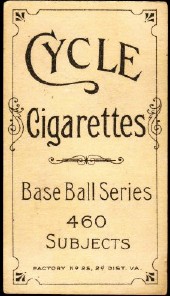 Factory #30 The total count for this 460-only Series group is 156 cards. At this point in time, I have over 100 cards into this project. About 50 more to go. And their UZIT backs will most likely prevent me from attaining this goal. 2nd I for one do not care to own a Honus Wagner (it is overrated). The thrill I got when I acquired this unique McGraw / UZIT card was tremendous. Furthermore, so was my acquisition of Eddie Plank....SWEET CAPORAL 150 (Factory #30) TED Z T206 Reference . |
|
#76
|
||||
|
||||
|
Quote:
O'Hara STL (269) Demmitt STL (292) Cranston (366) Violat (379) Helm (389) Mullaney (391) Ryan (411) Hickman (422) Perdue (423) Greminger (426) There are about 100 more copies of a Cranston compared to O'Hara STL. That is a difference....but is it that huge of a difference? You can pick up a Cranston in low grade for less than $150-200. O'Hara STL goes for like $3k-4k now. Theoretically, the max number of T206 520 card sets is 269.....obviously there are likely a bunch of raw copies out there, and I suspect some of the cards have been crossed over so the 269 is close, but not exact. If we say 300, that means there can only be 300 sets of 520, which does make that card pretty important, all things considered. Assuming you care about a 520 set, of course  The idea of putting together a master set is really interesting. I assume David Hall gave up on his project because he started to hit a lot of the 1 of 1s and when he found who had the card and they said they wouldn't sell, he didn't want to wait 5 years to see if another copy surfaced.
__________________
My T206 research thread My T205 Census thread Want list: M101-2, T205s (American Beauties) Last edited by 53toppscollector; 08-22-2022 at 05:40 PM. |
|
#77
|
||||
|
||||
|
Quote:
I just did a quick search of past sales for Demmitt, O'hara and Cranston this is the graded vs ungraded numbers Cranston 322 total 250 - graded 72 - ungraded Demmitt 234 total 223 graded 11 - ungraded O'Hara 210 total 206 graded 4 - ungraded Last edited by Pat R; 08-22-2022 at 06:42 PM. Reason: added sales |
|
#78
|
||||
|
||||
|
Sure, there are definitely more copies of Cranston than there are O'Hara, but I guess the question is, how many more? From your numbers, there were 112 more sales of the Cranston than O'Hara. So there are more, definitely. But, do you think are, say 600 Cranstons in total? 700? If there are, say, 50% more Cranstons than what shows up on the combined pop report, then are there are also 50% more copies of a more common card like Herbie Moran?
My point was more, the O'Hara/Demmitt are very rare. But based on population reports, the Southern Leaguers are also very rare but do not command anywhere near that premium. An O'Hara costs basically 20x a Southern Leaguer, and if you map that out, then 20x the population would be like 5300, and I think we can agree there aren't 5300 copies of Cranston out there. It is all relative, obviously. My point was only that in degrees of rarity, the pricing never seems to line up properly. |
|
#79
|
||||
|
||||
|
Quote:
Using Ludgren as one example his total pop numbers are 580 for Chicago and 489 for KC but his KC cards sell for 20% of what his comparative Chicago cards sell for. |
|
#80
|
||||
|
||||
|
Quote:
|
|
#81
|
||||
|
||||
|
I think you are right, I think SGC may have updated their pop report, I suspect that is where I originally saw it. Because they now show the 1911 Broad Leaf (the 460) as having a pop of 3 and none for the 350, while PSA shows 1 for the 460, so the total pop of the 460 would now be 4. When I looked at the numbers a few months ago, it was only a pop 2 combined between PSA and SGC (and really 3, if they had miscategorized one of the 460s as as 350. So either they just cleaned up the mistake, or another one got graded in that time too.
I will update that later, thanks for catching it. |
|
#82
|
||||
|
||||
|
Quote:
I Only know of two Red Cobb broadleaf 460's The One Jamie had Cobb BL460.jpg and the one that was discovered in 2018 that was originally graded by SGC and has since been crossed over to PSA Cobb BL460 SGC.jpg Cobb BL460 PSA.jpg I haven't heard of a new example but Jamie would probably know if there is one. |
|
#83
|
||||
|
||||
|
Not sure this is going to be a full fledged post, but it was something I thought was interesting as I am slowly working through my Sweet Cap census, based on a comment Steve B made.
There are a few interesting SweetCap patterns I've noticed before, but here is one in Print Group 2 that I find interesting. There are a batch of cards that seem to be a lot more scarce than the other SweetCaps within the print group, along with 2 more extreme cases. Lundgren KC has 37 SC 350s at PSA and 22 SC 350s at SGC for a total of 59. Compare that to his P350 (187 at PSA, 137 at SGC) Knight (Portrait) has 25 SC 350s at PSA and 16 SC 350s at SGC for a total of 41. Knight has 352 combined (PSA+SGC) Piedmonts. The average number of combined (PSA + SGC) SC 350s for a Print Group 2 subject is 147. The average number of P350s is 388. That ratio is about 2.6:1 Piedmont to SC. For Lundgren, the ratio is 5.5:1 and Knight's is 8.6:1. This below group of cards are more than 2 standard deviations from the average of a 2.6:1 ratio, Piedmont to SweetCap (the ratio is in the column next to the SweetCap population total). But there doesn't appear to be any real pattern here in the other backs. Their populations just look like outliers. Was there a reason these cards have a lot more Piedmonts than Sweet Caps, or in Tannehill's case, almost the exact same number of Piedmonts and SweetCaps? Lundgren was traded from CHC to KC, so we know why his card is special. What about the rest? (note, the numbers in the chart below are slightly different for Lundgren and Knight, they haven't been updated in months, but I just got their updated totals from PSA/SGC now for the above paragraphs) 
|
|
#84
|
|||
|
|||
|
That's interesting.
I have an idea on cards that are lower population than usual, but the Tannehill is a puzzle. I know for sure that some 350 subjects were printed in two different runs, probably more like 4 for at least a few of them. The same for 150, at least some subjects were done in 3 different printings and on at least one subject are identifiable. 150 and 350 were individual from each other, with some probable exceptions. I'm not sure if 350s were carried over to 350-460, or if they redid things again. I just haven't really looked yet. On many cards where the population of say a 350 is much lower than the 150 I believe some of that is due to generically printed fronts that were already finished getting used up to fill the first orders for the next series. The best example is the single Schulte P350 that was found a few years ago. Up til then it was a 150 only, and I believe still should be. So how would a card get printed enough to be unbalanced towards being more common? I suppose Tannehill could have been used as a fill in card that got double printed a couple times. But that seems like an odd choice. And I'm not really seeing a reason his card would be graded more often. |
|
#85
|
||||
|
||||
|
Tannehill is a real mystery to me. His Piedmont population is the lowest of any of the Print Group 2 subjects. He actually has the same number of P350s as Shaw (Providence), but Shaw only has 75 total SweetCap backs (one of the lowest totals of any 350 series) and Shaw only has a AB 350, Cycle 350, Polar Bear, Sovereign and BL 350, while Tannehill has the full compliment of 350 backs, plus EPDG and Old Mill.
|
|
#86
|
||||
|
||||
|
I think pop number oddities like your Tannehill example has to do with the print timing and print duration you see this quite a lot especially with print group 1 and 2 subjects. I think at least print group 1 and 2 were printed in several stages for example Tannehill is a print group 2 subject and I think the Piedmonts in this group were printed in 5-6 stages and the Sweet caporals were printed in 2 or 3 stages and if we can ever figure the stages out you would be able to figure out how many and which stages certain subjects were printed in. That's one thing I'm trying to figure out by researching every print flaw I find.
The more research I do the more I'm convinced that The T206's were also printed in more than one American Lithograph facility at the same time and probably each facility had different sheet layouts. Last edited by Pat R; 09-02-2022 at 12:47 PM. |
|
#87
|
||||
|
||||
|
James, your chart above is very good. Thank you.
I have substantial experience with the yellow Chance portrait and the Evers yellow sky (Chicago on shirt), since I am (insanely) working on back runs of both. The pop report on Evers is incorrect - there are two (2) graded BL 460s. My PSA 2 used to sit in an SGC flip before Derek H crossed it over to PSA, so the the SGC one is double counted. Regarding the yellow Chance, I can think of 3 red Hindus as I type this, but I am almost sure there are at least 5. Regarding the BL 350, I dont know how many there are but I have not been able to find more than one (and I look pretty hard). So my gut is the BL 350 is tougher than the RH Pop reports are useful guides and can provide a general idea of a backs scarcity. But when it comes to comparing cards with 1-5 graded examples, it can be misleading. All it takes is someone to cross a PSA to an SGC (or vice versa) and a pop 1 doubles instantaneously Keep up the great work!! |
|
#88
|
|||
|
|||
|
The more rabbit holes I go down and track, the more I think you are probably correct and we are going to end up here. Its going to be very difficult to ever prove it conclusively as it requires not just a sheet or two but a lot of uncut material. I think some other sets were done this way by the AL and its affiliates. It explains a lot of the random scarcities of front/back combos across the big print run sets and, it really fits with our research last year into the complicated setup and relationships between the AL and its affiliates or independent partners. They had multiple lithographers working together for small print runs of contracted items; why not for huge orders?
|
|
#89
|
||||
|
||||
|
Great work!
The pop reports are useful however pictures would be better. If you had pics/scans of the BL460s you could easily see that some have been crossed over and thus double counted. Pat is correct there are only two graded Cobb BL460s the ones he provided scans of. I have never seen the one SGC has listed as Authentic. Ryan is correct there are only two graded Evers BL460s (both graded by PSA now) the one he has that was crossed over from SGC 2 #8175964-002 and the one in the Hill collection. Pop reports show there are 104 graded BL460s (PSA - 47 and SGC - 57) but in reality less than 100 actual cards are currently graded due to cross over. Obtaining pics should not be that big of a challenge if you have time looking through old auction house listings.
__________________
Tony Collecting: 1909-1911 T206 Southern Leaguers 1914 Cracker Jack Set (96 out of 145) |
|
#90
|
||||
|
||||
|
BL 460 PSA pops of the 29 subjects, 3 do not have any graded
Baker - 2 (PSA 1.5 and PSA 1) Brown - 1 (PSA 4.5) Cobb - 1 (PSA 1MK) Davis - N/A Donlin - N/A Doolan - N/A Dougherty - 3 (PSA 4, PSA 2.5 and PSA 1) Downey - 3 (PSA 2, PSA 2 and PSA Auth) Elberfeld - 3 (PSA 6, PSA 1.5 and PSA 1) Evers - 2 (PSA 2 and PSA 2) Griffith - 2 (PSA 1 and PSA Auth) Johnson - 2 (PSA 4.5 and PSA 3.5) Joss - 1 (PSA 2.5) Kleinow - 1 (PSA 2) Konetchy - 1 (PSA 3) Magee - 1 (PSA 2.5) Mathewson - 2 (PSA 3 and PSA Auth) McIntyre - 3 (PSA 3, PSA 3 and PSA 2.5) Murphy - 2 (PSA 4 and PSA 4) O'Leary - 1 (PSA 1.5) Reulbach - 3 (PSA 3, PSA 3 and PSA 1) Rucker - 2 (PSA 3 and PSA 2) Seymour - 1 (PSA 4) Snodgrass - 2 (PSA 3.5 and PSA Auth) Stahl - 2 (PSA 2.5 and PSA Auth) Street - 2 (PSA 3 and PSA 1) Sweeney - 1 (PSA 2) Willis - 2 (PSA 3.5 and PSA 2) Young - 1 (PSA 5.5)
__________________
Tony Collecting: 1909-1911 T206 Southern Leaguers 1914 Cracker Jack Set (96 out of 145) |
|
#91
|
||||
|
||||
|
Graded Evers BL460s (not my cards)
__________________
Tony Collecting: 1909-1911 T206 Southern Leaguers 1914 Cracker Jack Set (96 out of 145) |
 |
|
|
 Similar Threads
Similar Threads
|
||||
| Thread | Thread Starter | Forum | Replies | Last Post |
| Ty Cobb Back Scarcity vs. Brown Old Mill Back Scarcity | DixieBaseball | Net54baseball Vintage (WWII & Older) Baseball Cards & New Member Introductions | 34 | 06-28-2013 11:04 AM |
| Red Cross vs. Red Hindu--scarcity & pricing | nolemmings | Net54baseball Vintage (WWII & Older) Baseball Cards & New Member Introductions | 4 | 04-28-2013 01:23 PM |
| E107 Scarcity & Pricing | Collect Equity | Net54baseball Vintage (WWII & Older) Baseball Cards & New Member Introductions | 3 | 05-08-2011 06:20 PM |
| T206 back scarcity and pricing analysis | Archive | Net54baseball Vintage (WWII & Older) Baseball Cards & New Member Introductions | 4 | 08-19-2007 05:09 PM |
| T207 Pricing and Scarcity | Archive | Net54baseball Vintage (WWII & Older) Baseball Cards & New Member Introductions | 6 | 12-25-2004 08:41 AM |